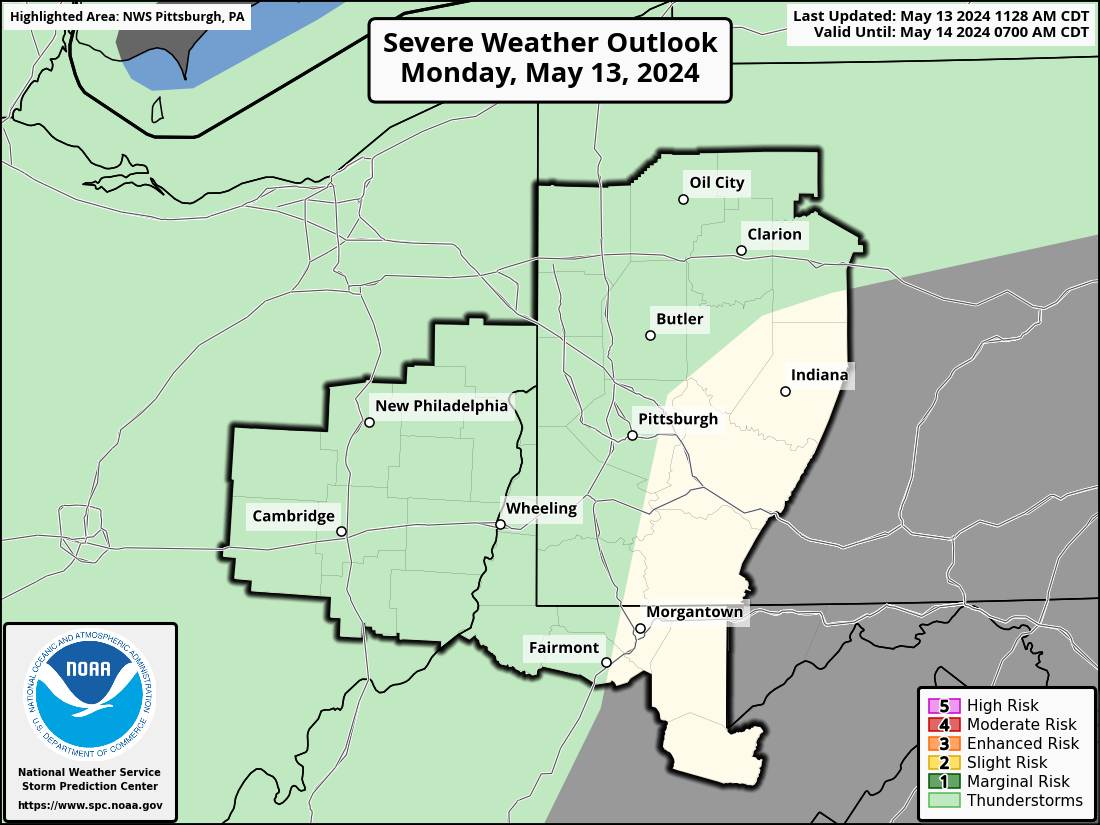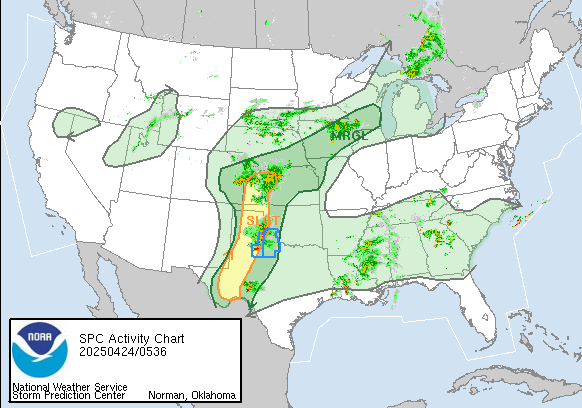|
Forecast
Radar
Pittsburgh Radar Status
Alternate Radar
Satellite
Hazards Map (Local)
Hazards Map (U.S.)
Area Forecast Discussion
Warnings
Special Weather Statements
Hazardous Weather Outlook
Public Information Statement
Air Quality
Space Weather
Convective Outlooks:
Day 1
Day 2
Day 3
Days 4-8
Great Lakes Water Levels
Flood Potential Outlook
Daily Hydrometeorological Data Summary
Hydrologic Statement
Hydrologic Summary
Area Rainfall Report
Quantitive Precipitation Forecast Discussion
Rain Outlook
Excessive Rain Outlook
Exessive Rainfall Discussion
U.S. River Flood Outlook Map
Surface Analysis Maps
Local Storm Reports (All NWS Pittsburgh areas)
Fire Weather Outlook
Mesoscale Discussions - All States
Ultraviolet Index Map
Child Amber Alerts - All States
|
Scroll down for text


 Untitled Document
Untitled Document
ACUS01 KWNS 251940
SWODY1
SPC AC 251938
Day 1 Convective Outlook
NWS Storm Prediction Center Norman OK
0138 PM CST Thu Dec 25 2025
Valid 252000Z - 261200Z
...THERE IS A MARGINAL RISK OF SEVERE THUNDERSTORMS ACROSS MUCH OF
COASTAL CALIFORNIA AND THE CENTRAL VALLEY...
...SUMMARY...
An isolated risk for severe gusts/localized wind damage and perhaps
a brief tornado will be possible today into this evening along much
of the California Coast and portions of the Central Valley.
...20z Update...
The previous outlook reasoning remains on track, and no changes were
made with this update.
A few thunderstorms had developed over the Sacramento Valley since
18z, where partial clearing was noted and weak buoyancy (200-300
J/kg) was present. Offshore, an increase in lightning was noted as
the next upstream vorticity maximum moves towards the CA Coast.
Although buoyancy will remain weak, stronger low/mid-level flow will
become re-established later this afternoon/evening and will support
an isolated risk of strong/severe wind gusts with a few
stronger/sustained convective elements, and low-level hodographs
will be sufficiently curved to conditionally support a brief
tornado.
..Bunting.. 12/25/2025
.PREV DISCUSSION... /ISSUED 1026 AM CST Thu Dec 25 2025/
...California...
Recent satellite imagery shows a mid/upper-level low over the
eastern Pacific and a negative-tilt shortwave trough moving
northward along the northern CA and OR Coast. An upstream mid-level
jet and associated vorticity maximum will move through the base of
the eastern Pacific upper low/trough and approach the San Francisco
Bay and northern CA vicinity this evening.
Strong to locally severe thunderstorms capable of producing mainly
isolated severe/damaging winds will remain possible with convection
today into this evening. Weak instability is forecast to persist
across much of coastal CA into the Central Valley, with cool surface
temperatures, saturated profiles, and modest lapse rates aloft
(reference the 12Z OAK sounding) limiting the development of greater
MUCAPE. Still, a favorable kinematic environment with enhanced
west-southwesterly mid/upper-level flow will conditionally support
occasional strong to severe convection, contingent on sufficiently
deep/sustained updraft development.
Low-level hodographs are forecast to remain enlarged enough to yield
a low risk for a brief tornado across much of the Marginal Risk
area. Consensus of latest model guidance indicates low/mid-level
flow will weaken somewhat this afternoon before gradually
re-intensifying this evening as the next embedded shortwave trough
and associated mid-level jet overspread coastal northern/central CA.
A mix of linear bands and cellular convective structures may
continue to pose an intermittent risk for isolated damaging gusts
and perhaps a brief tornado into this evening/tonight, before the
severe threat gradually diminishes towards 12Z early Friday morning.
$$
|



